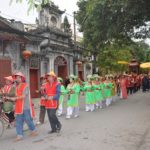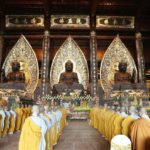“We have reached our destination!” my Thai companion, Jiratha Jamsuwan, exclaimed excitedly as we entered the reception lobby of Lady Hill Resort. This newly-opened 5-star resort is conveniently situated across from the iconic Fansipan Mountain in Sapa Town, Lao Cai Province.
Our arduous journey on the sleeper bus brought us to this destination, with the sole intention of experiencing the mesmerizing beauty of the clouds and conquering Fansipan Peak, the highest point in Indochina.
| The Fansipan mountain is known as the “gateway to the sky” in Vietnam. Photo: Nguyen Minh Tu |
Symbolic Mountain of Indochina
Climbing Mount Fansipan is widely regarded as the ultimate adventure for those captivated by the charm of Southeast Asia and the stunning splendor of northwest Vietnam.
Although Vietnam does not boast a mountain as its national symbol, akin to Japan’s majestic Mount Fuji or Switzerland’s renowned Matterhorn, our nation takes immense pride in Mount Fansipan – the highest summit in the former French Indochina. Spanning across Vietnam, Cambodia, and Laos, this formidable peak stands as a testament to our rich natural heritage.
It is not by chance that the Vietnamese have a popular saying: “Everyone has their own Fansipan to conquer”, serving as a metaphor for their biggest aspirations in life.
Fansipan
Fansipan, also known as Hua Xi Pan in the local language, is referred to as “the swaying giant rock”.
According to the Vietnam Institute of Geological Sciences, Fansipan is a magnificent granite mountain that emerged from the depths of the earth over 250 million years ago.
Northwest Vietnam is renowned for its treacherous terrain, widely regarded as one of the most formidable in Southeast Asia. Tucked away within this rugged landscape lies Fansipan, an integral part of the Hoang Lien Son mountain range, celebrated for its intricate topography that dominates the northwest region. It is worth noting that the Hoang Lien Son mountain range is reputed to mark the southeastern boundary of the majestic Himalayas, a fact confirmed by multiple sources.
| The famous mountain is known as the roof of Indochina. Photo Le Viet Khanh |
Discover the beautiful Hidden Paradise
The adventure to conquer Mount Fasipan commenced at the crack of dawn on our second day in Sapa, fueled by Jiratha’s unwavering determination to explore this fabled summit.
In the past, ascending the Roof of Indochina was a challenge exclusively undertaken by intrepid individuals who possessed the bravery and physical endurance to trek through dense forests for days before reaching the peak.
In today’s era of modern technology, the exploration of Fansipan has become immensely convenient and accessible to foreign travelers. With its alluring wonders, this captivating destination can now be extensively experienced in just a single day.
Experience the awe-inspiring beauty of nature as you embark on a cable car ride to the highest altitudes. Prepare to be mesmerized by a captivating panorama that seamlessly merges the boundaries between land and sky, as the breathtaking sea of clouds stretches out before you. Beneath your feet lies a dream-like landscape, featuring golden terraced rice fields, lush green forests, and cascading waterfalls. This destination boasts unparalleled splendor, making it a must-visit location unlike any other in Vietnam.
| The beauty of the “gold season” of Muong Hoa Valley, Sapa Town in autumn. Photo: Chu Nga |
After a journey of just over an hour on foot and a scenic cable car ride, we finally reached the summit of Fansipan. The misty clouds and dense forest surrounding the mountain give it a truly awe-inspiring and otherworldly allure.
In the hazy atmosphere, reminiscent of delicate chiffon, one can discern the ethereal presence of spiritual edifices that encapsulate the profound essence of Vietnamese temples dating back to the 15th and 16th centuries.
Jiratha gracefully extends her arms wide, taking in a deep breath as she revels in the awe-inspiring beauty of the boundless sky. The air is crisp, carrying with it a hint of moisture. With reverence in her heart, she shares, “Let us cherish this moment, for it is truly one of the most precious experiences of my life.”
Four Seasons in One Day
Fansipan, renowned for its stunning landscape, is also famous for its four enchanting seasons. Each season brings a stunning display of vibrant blooms, enhancing the natural beauty of the region. In this mesmerizing realm, the tourism developer assumes the responsibility of a caretaker, meticulously curating and fostering a diverse collection of flowers.
| Spring on the Fansipan Mountain. Photo: Sun World Fansipan Legend |
In the spring, the majestic mountains of Fansipan come alive with vibrant flowers that bloom above the clouds. Known as the “Gateway to the Sky,” Fansipan offers a breathtaking scenery of cherry blossom forests and Himalayan cherry blossoms. The enchanting landscape is accompanied by the melodious birdsong in the misty mornings, creating a truly magical atmosphere. Additionally, the ancient land of Fansipan showcases its rich history with the vibrant display of 300 to 400-year-old rhododendrons, forming a beautiful tapestry of colors.
When summer arrives, Fansipan becomes a delightful ensemble of vibrant blossoms and gentle, refreshing breezes. Within the majestic grounds of Sun World Fansipan Legend, visitors are greeted by Vietnam’s largest rose valley, showcasing the enchanting red hues of the exquisite climbing roses unique to Sa Pa. Nestled amidst the rolling hills are stunning fields of blooming verbena, their exquisite purple petals resembling ethereal clouds gracefully swaying in the warm sunlight.
Fall is the enchanting “cloud-hunting” season in Fansipan, where the majestic peak stands proudly at an altitude of 3,143 meters. Witnessing the sight of fluffy clouds gracefully drifting over this sacred peak is a mesmerizing experience. Moreover, the terraced rice fields adorning the mountain slopes resemble magnificent golden waterfalls, seemingly descending from the heavens above.
Visitors to Fansipan are greeted with the breathtaking sight of vibrant red crocosmia flowers, which beautifully accentuate the mountainous landscape. As autumn embraces the region, a unique shade of red illuminates the scenery, distinguishing it from temperate environments.
| A blanket of snow on the summit of Fansipan. Photo: Vu Minh Quan |
During winter, the temperature at the summit of Fansipan can reach as low as -9 degrees Celsius, providing a unique chance to witness snow in this part of Southeast Asia. Occasionally, the mountain can be covered in over half a meter of snow, resulting in a captivating scenery that evokes a delightful Nordic fairy tale.
Jiratha’s journey to explore Fansipan took on a special significance during her time in Chiang Mai, Thailand. Known for its two main seasons, “hot” and “scorching,” the unique climate made her visit to Sapa all the more exciting. As she experienced the late summer chill on Fansipan, Jiratha developed a desire to return and embrace the cold weather more frequently.













